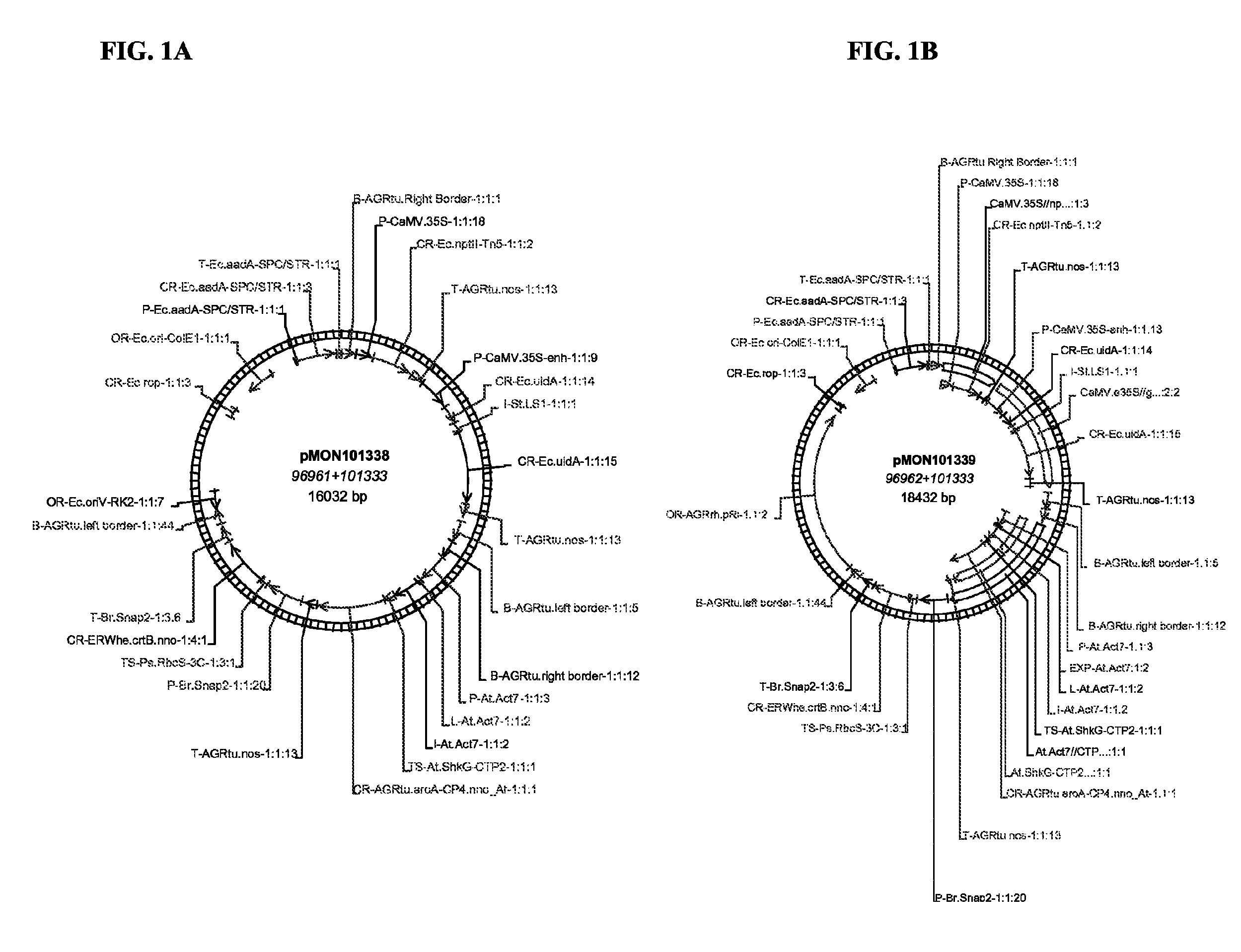Methods and compositions for obtaining marker-free transgenic plants
a technology of transgenic plants and markers, applied in the field of transgenic plants, can solve the problems of high labor intensity of previously described screening processes
- Summary
- Abstract
- Description
- Claims
- Application Information
AI Technical Summary
Benefits of technology
Problems solved by technology
Method used
Image
Examples
example 1
Preparation of 2T-DNA Vectors with an Identification Sequence and Marker Gene, and a Gene-of-Interest
[0108]Two T-DNA plant expression vectors, pMON67465, pMON101338 and pMON101339 (FIG. 1), were constructed according to standard molecular cloning procedure (Sambrook et al., 1989). One T-DNA includes a CaMV 35S promoter operably linked to an nptII gene encoding resistance to kanamycin and a CaMV 35S promoter operably linked to a GUS reporter gene. The other T-DNA comprises a napin:ctp-crtB: napin 3′ cassette and a 35S:ctp:CP4 EPSPS cassette, that confers glyphosate resistance. The crtB in pMON67465 with oriV replication origin was driven by a 1.8 kb seed-specific napin promoter and 1 kb napin terminator from Brassica napus. The crtB in pMON101338 with oriV replicon and in pMON101339 with pRi replication origin was driven by a shorter version of napin promoter (1 kb) and terminator (0.3 kb). The crtB gene, encoding a phytoene synthase from Erwinia sp. confers orange color to soybean s...
example 2
Transformation and Regeneration of Soy Explants with pMON67465
[0109]Soybean (cv. A3244) tissues were transformed with pMON67465 (FIG. 1) via an Agrobacterium-mediated method, essentially as previously described (U.S. Pat. No. 6,384,301, herein incorporated by reference). Briefly, hand excised soy meristem explants were co-cultivated with Agrobacterium for 2-4 days at 23° C., transferred onto WPM solid medium with 75 μM glyphosate selection in a PLANTCON and cultured at 28° C. under 16 / 8 light / dark period. After two weeks, the explants were transferred to fresh WPM medium and cultured until shoot harvest. After 2 months, shoots with true trifolia were cut and cultured onto BRM rooting medium for 2-4 weeks. The rooted plantlets were grown in greenhouse for seed maturation. Among 40 events analyzed, 72.5% displayed co-transformation with both T-DNAs. 45% of the 40 events contained both nptII and gus genes. Event A33908, containing T-DNAs from pMON67465, was further analyzed.
[0110]Addit...
example 3
CrtB / GUS / CP4 Expression in Soy Event A33908 and R1Progeny Seed
[0112]Visual inspection of tissues from event A33908 (FIG. 2) indicated that stems and young unfolded leaves displayed an orange cast. Leaf and root tissue was otherwise phenotypically normal in CrtB-expressing plants. Seed coats from seed of the R0 plant (i.e. the R1 generation) displayed slight CrtB expression, while the cotyledons of A33908-derived seed displayed a distinct orange color and some with a wrinkled phenotype (FIG. 3).
[0113]Twelve immature R1 seeds from event A33908 were dissected from the seed coat and subjected to CP4-EPSPS ELISA, and CrtB and GUS-visual analyses (FIG. 4). Segregation of the CrtB, GUS, and CP4-EPSPS phenotypes was evident. 9 / 12 seed were positive in all three assays. 1 / 12 seed was CrtB and CP4-EPSPS positive, but GUS negative, showing segregation of the two T-DNAs of pMON67465, with loss of the gus gene. 2 / 12 seed were CP4-EPSPS ELISA negative. Both of these seed were CrtB negative and GU...
PUM
| Property | Measurement | Unit |
|---|---|---|
| excitation wavelength | aaaaa | aaaaa |
| size | aaaaa | aaaaa |
| pest resistance | aaaaa | aaaaa |
Abstract
Description
Claims
Application Information
 Login to View More
Login to View More - R&D
- Intellectual Property
- Life Sciences
- Materials
- Tech Scout
- Unparalleled Data Quality
- Higher Quality Content
- 60% Fewer Hallucinations
Browse by: Latest US Patents, China's latest patents, Technical Efficacy Thesaurus, Application Domain, Technology Topic, Popular Technical Reports.
© 2025 PatSnap. All rights reserved.Legal|Privacy policy|Modern Slavery Act Transparency Statement|Sitemap|About US| Contact US: help@patsnap.com



